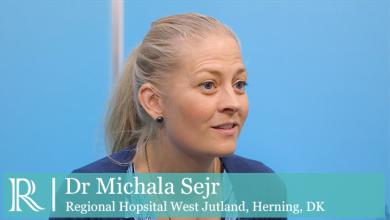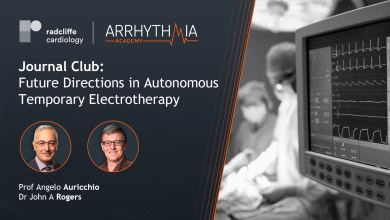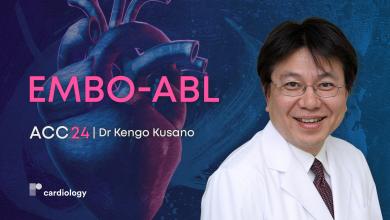Search results
Author(s):
Michala Sejr
Added:
5 years ago
Dr Michala Sejr (Institut for Klinisk Medicin, Herning, DK) discusses comparison of simultaneous two-day external loop recording and Holter monitor recording for detection of atrial fibrillation in patients after acute ischemic stroke or transient ischemic attack
Filmed by Radcliffe Cardiology on-site at ESC 2018
View more
Author(s):
Angelo Auricchio
,
John A Rogers
Added:
1 year ago
In this Arrhythmia Academy Journal Club episode, Prof Angelo Auricchio (Fondazione Cardiocentro Ticino, CH) is joined by Professor John A Rogers, award-winning physical chemist and a materials scientist from Northwestern University, US.
Join this discussion on an exciting new technology, a transient closed-loop system that combines a time-synchronized, wireless network of skin-integrated devices…
View more
Author(s):
Kengo Kusano
Added:
1 week ago
ACC.24 — We are joined by Dr Kengo Kusano (National Cerebral and Cardiovascular Center, JP) to discuss the findings from the Embo-Abl Study.Embo-Abl is a multicenter prospective randomized study which aims to compare the incidence of periprocedural cerebral embolisms caused by catheter ablation of atrial fibrillation (AF) between cryoballoon and radiofrequency ablation. 230 patients with AF from…
View more
Author(s):
Penelope A Boyden
,
Wen Dun
,
Bruno D Stuyvers
Added:
3 years ago
Abnormalities in electrical rhythm were studied by Einthoven at the start of the 20th century. In the 1940s, studies by Bozler et al.1 described contractile signals that appeared to be ‘triggered’ heart beats. Today we use the term delayed afterdepolarisations (DADs) to refer to oscillations in voltage that follow a driven action potential.
In the mid-1970s, progress was made when Lederer and…
View more
Author(s):
David J Sprenkeler
,
Marc A Vos
Added:
3 years ago
The concept of post-extrasystolic potentiation (PESP), which describes the phenomenon of increased contractility of the beat following an extrasystole, has intrigued physiologists and clinicians for more than 120 years. Since its first description in 1885 by Oskar Langendorff,1 PESP has become a widely debated concept, not only for its fundamental basis but also because of the potential…
View more
Author(s):
Tauseef Akhtar
,
Ronald Berger
,
Joseph E Marine
,
et al
Added:
3 years ago
AF is a common and clinically impactful arrhythmia. Given both the association of AF with aging and the increasing number of elderly people in the general population, it follows that many AF patients are of advanced age. The management of AF in the geriatric population is associated with several challenges, including multiple comorbidities, increased toxicity of antiarrhythmic drugs (AAD), an…
View more
Author(s):
Saagar Mahida
,
Frédéric Sacher
,
Nicolas Derval
,
et al
Added:
3 years ago
Atrial fibrillation (AF) is the most commonly encountered arrhythmia in clinical practice. The discovery that pulmonary veins (PV) play a prominent role in the pathogenesis of AF has revolutionised the management of AF. PV isolation has become the most widely used technique for treatment of paroxysmal AF. Since the initial discovery implicating PVs in AF pathogenesis, the mechanistic link between…
View more
Author(s):
David Schaack
,
Boris Schmidt
,
Shota Tohoku
,
et al
Added:
1 year ago
Author(s):
Cristina E Molina
,
Jordi Heijman
,
Dobromir Dobrev
Added:
3 years ago
Optimal cardiac function depends on appropriate rate and force of contraction, with specific cardiac regions having developed particular beat-to-beat properties depending on their individual functions. For example, isovolumetric contraction time is shorter in the right ventricle (RV) than in the left ventricle (LV). At the cellular level, cardiac function is regulated by regional cardiomyocyte…
View more
Author(s):
Satish Raj
,
Robert Sheldon
Added:
3 years ago
Syncope and palpitations are two common clinical presentations, and both pose difficulties in the approach to their management. They are both symptoms of a number of syndromes, and an efficient approach with targeted therapy is challenging. Cardiac arrhythmia specialists, who lack a compact and accessible guide to management, see many patients with these symptoms in consultation. Recognising this…
View more














